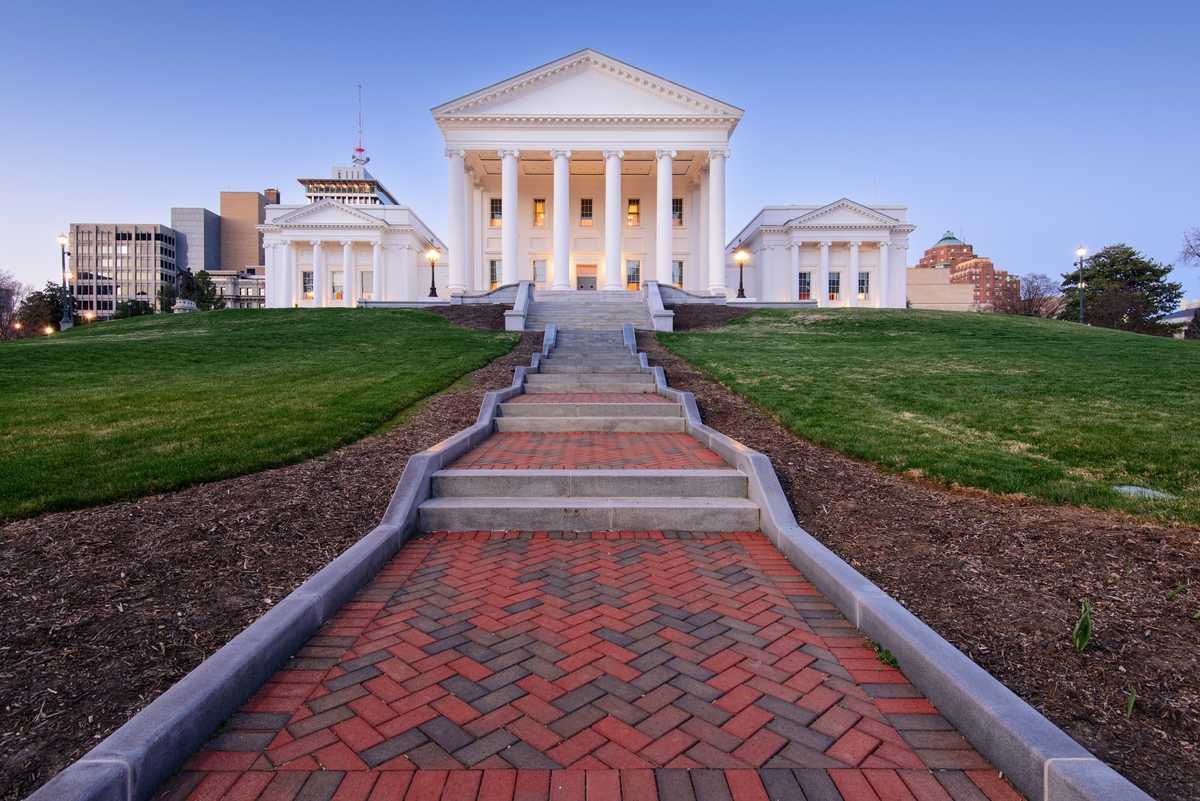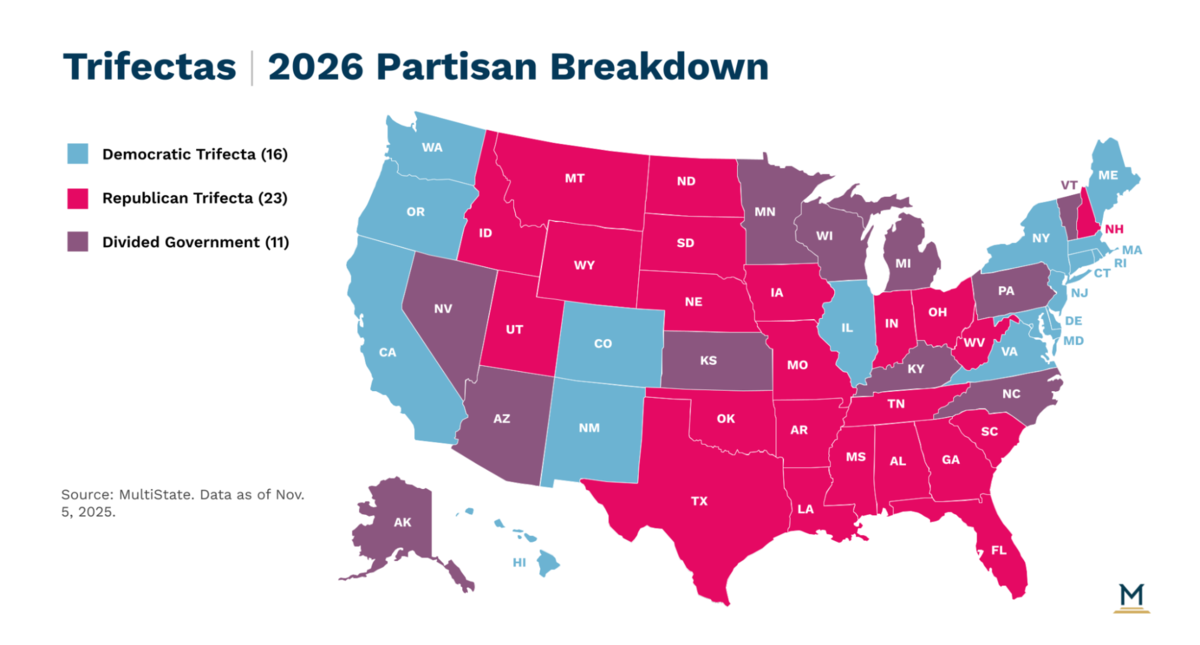
State Government Affairs, Elections & Campaigns
How Lieutenant Governors Are Selected (And Why It Matters)
December 10, 2025 | Bill Kramer
November 5, 2025 | Bill Kramer

Key Takeaways:
Four years ago, in the first year of President Biden’s term, Republicans surprisingly swept the Virginia statewide elections with Gov. Youngkin (R) at the top of the ticket and nearly unseated Gov. Murphy (D) in New Jersey while exceeding expectations by capturing a handful of seats in the legislature and unseating Senate President Steve Sweeney (D), the longest-serving Senate president in New Jersey history. But today’s political environment is very different with a Republican in the White House; Democrats made significant gains in the limited number of odd-year elections available to them. Of course, the big question is how things will turn out a year from now. But first, let’s dive into what happened yesterday.
Democrats had a very good night in Virginia. As expected, they recaptured the governor’s mansion as former U.S. Rep. Abigail Spanberger (D) soundly defeated Lt. Gov. Winsome Earle-Sears (R) at the top of the ticket. Similar to four years ago, when Gov. Youngkin led a Republican sweep of statewide elections, Democrats swept the statewide elections this year. Voters elected Ghazala Hashmi (D) as their next Lt. Governor and, somewhat surprisingly, after extremely controversial texts emerged during the campaign, Jay Jones (D) was elected Attorney General over incumbent Jason Miyares (R).
But these weren’t the only elections in Virginia. All 100 seats in the House of Delegates were up for election. Democrats began the night with their slim 51 to 49 seat majority in the House. But Democrats will significantly expand that majority for 2026 as it appears that they’ll flip 13 total seats, giving them a 64 to 36 majority in the House next year. The Senate wasn’t up for election in 2025, so the slim 21 to 19 Democrat majority will remain in that chamber.

Critically, this gives Democrats a new trifecta state (i.e., holding both the governor’s seat and both chambers of the legislature). Next year, Democrats will improve their total trifectas to 16 states, Republicans will still hold their nationwide lead with trifectas in 23 states, and only 11 states will have a divided government. This is close to the low point of non-trifecta states of 10 that we saw in 2024.

This year, forecasters expected a tighter governor’s race in New Jersey than in Virginia, and while that turned out to be true, that’s largely because of the unusually lopsided race in Virginia. In New Jersey, U.S. Rep Mikie Sherrill (D) still handily defeated former state Assemblymember Jack Ciattarelli (R) at the top of the ticket. Sherrill will replace term-limited Gov. Phil Murphy (D) next year, keeping the Garden State’s governor’s seat in Democrats’ hands. The only other statewide office up for election this year was Lieutenant Governor, where Dale Caldwell (D) defeated James Gannon (R).
Similar to Virginia, all 80 seats in New Jersey’s Assembly were up for election this year. Forecasters didn’t expect much movement in legislative seats, with perhaps the GOP picking up a seat or two from Democrats’ current 52 to 28 seat majority. Instead, Democrats appear to have expanded their already large majorities to at least 55 seats and potentially giving Democrats a supermajority in the chamber next year. The Senate wasn’t up for election this year, so Democrats will retain their 25 to 15 seat majority in 2026.
As expected, voters approved California Proposition 50, which allows the state to use a new, legislature-drawn congressional district map for 2026 through 2030. The state constitution currently requires a non-politician commission to draw congressional districts. Prop. 50 allows Democrats to respond to Republican efforts in other states to draw more partisan mid-decade congressional maps.
Another high-profile ballot measure is Maine Question 1, which was expected to be a closer vote. Question 1 would have required voters to present a photo ID for both in-person and absentee voting, repeal automatic absentee ballot sign-ups, and limit each municipality to a single drop box location regardless of population size. While voter ID ballot measures have a track record of success in other states recently, Mainers rejected Question 1 this year, keeping the status quo for the state’s election rules.
On the local level, voters in Seattle, Washington, approved Proposition 2, which raises taxes on large businesses to fund social services. Also in Washington, voters in Olympia appear to have rejected Proposition 1, which would have increased the city’s minimum wage to $20 and also would have adopted a “Bill of Rights” for workers to strengthen labor protections around scheduling and wages.
A handful of mayoral elections in major cities took place on Tuesday. Most cities have a heavy liberal constituency, and therefore, many mayoral elections are actually decided back in the spring during the primary election, and the general election is more of a formality. However, several general elections in major cities were competitive this year. The most obvious high-profile election this year was, of course, New York City, where state Assemblymember Zohran Mamdani (D) defeated former Governor Andrew Cuomo (I) to become the Big Apple’s next mayor. A less high-profile but more competitive mayoral contest took place in Miami, where neither Miami-Dade County Commissioner Eileen Higgins (D) nor Former USCIS Director Emilio Gonzalez (R) was able to secure over 50% of the vote total, so these two candidates will face off again in a runoff election scheduled for December 9.
Democratic incumbents secured reelection in Atlanta, Boston, Cincinnati, and Cleveland, with liberals winning open mayoral races in Detroit and Pittsburgh. In Seattle, incumbent Mayor Bruce Harrell (D) holds a slim lead against challenger Katie Wilson (D).
In Minneapolis, incumbent Mayor Jacob Frey (D) led state Sen. Omar Fateh (D) as of late Tuesday night, but he failed to receive over 50% of the vote in the first round of ranked choice voting. After the second round was tabulated on Wednesday morning, Mayor Frey secured his reelection to a third term in Minneapolis.
In Pennsylvania, voters decided to retain three liberal justices on the state supreme court. The court currently has a 5-2 liberal majority, so if the voters had decided not to retain the judges, the court would have been deadlocked with a 2-2 split. Two of the justices retained will serve additional 10-year terms, while the third will serve until 2027 when she’ll hit the mandatory retirement age of 75.
We’re keeping an eye on Public Utility Commissions and Public Service Commissions as we expect electricity bills to be a campaign issue going forward. As we recently highlighted, members of these key commissions are often appointed by governors or legislatures, but many are elected directly. Georgia is a state that elects its members of the Public Service Commission. Although the commissioners are elected to “districts’ they’re actually statewide elections. Two seats were up this year, and in both races Democratic challengers defeated Republican incumbents. Notably, this is the first time that Democrats have won a non-federal statewide election in Georgia in nearly 20 years.
There are always a scatter shot of vacant state legislative seats that get filled during any election cycle, and this year is no exception. The biggest such vacancies were in the Minnesota Senate, where Democrats needed to win one of two special elections in order to maintain their one-seat majority in the chamber. They accomplished that goal when Amanda Hemmingsen-Jaeger won the election for District 47.
Mississippi held special elections for 11 Senate seats and 6 House seats on Tuesday, although 7 of the races were uncontested. This is an unusual number of special elections, but 14 of the seats were redrawn after a federal court ordered new maps, holding that the previous maps diluted African-American voters. It appears that Democrats have gained three Senate seats in these special elections, which, if the results hold, would break the GOP’s supermajority in the chamber. Another two Senate seats appear to be heading to runoff elections on Dec. 2.
In Washington, nine legislative seats were up for grabs in special elections on Tuesday. Republicans hoped to flip two of the five Senate seats, but it appears that Democrats were able to defend these swing districts and keep the seats.

December 10, 2025 | Bill Kramer
-238a17-400px.jpg)
December 10, 2025 | Bill Kramer

October 27, 2025 | Billy Culleton